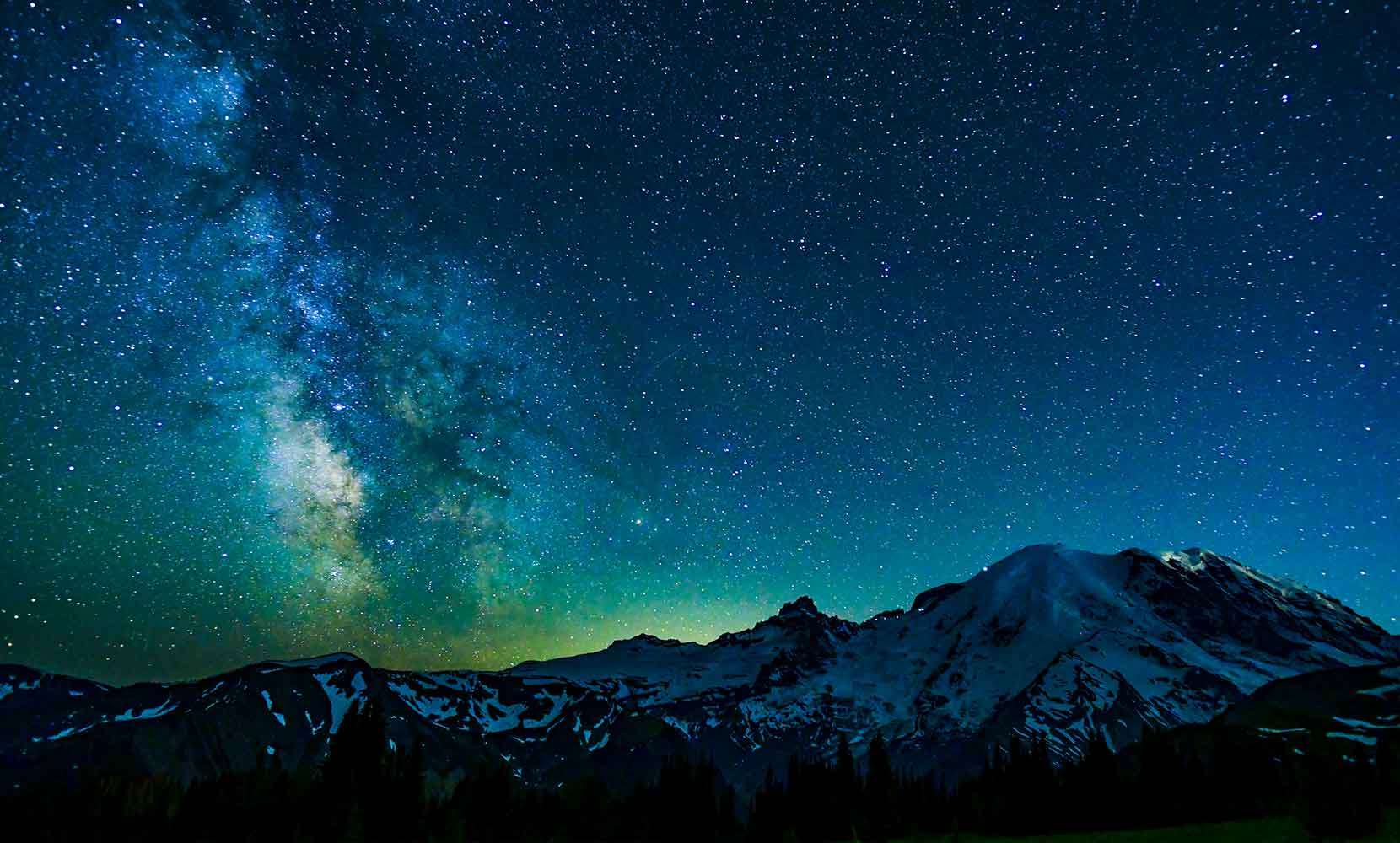
Portland Magazine
February 22, 2023
Story and photo by Alan Herold ’68

TO MAINTAIN MY equilibrium and fuel my positive attitude during trying times, I have mounted a personal campaign to establish a more intimate connection with the natural world. In part, that includes embracing the directive from the meditations of Marcus Aurelius that we “live as on a mountain.”
In mid-July last year, I made a private pilgrimage to Mount Rainier National Park. I arrived midafternoon and hiked to higher elevations on Sourdough Ridge on the mountain’s northern flanks. At 6,400 feet, the meadows were adorned with wildflowers, hemlock, alpine fir, and Engelmann spruce. Seven miles away, at 14,400 feet, was the summit—a staggering mass of exposed basalt and glacier. The warm, comfortable day under clear skies felt like a blessing.
Then I waited.
It’s one of my passions to capture and share the compelling night scenes of the heavens that most often elude us. My camera is tripod-mounted and an automatic timer directs the sequence of exposures, so I am free to relax and absorb the fantastic developments overhead. This day, I started at transitional twilight—at 9:45 p.m.—when the sky was a dusky, alluring cobalt blue. I wasn’t the only photographer. I could hear a bit of chatter as a handful of the brightest stars started to materialize.
By 11 p.m., the core of the Milky Way had scrolled to the west, the night canopy was completely dark, and the whole array was brilliant: innumerable stars, nebulae, constellations, gas clouds, the occasional glint of a satellite. Sagittarius is embedded in the lower portion of the core, and I could see the bright star Antares hovering off to the right. The mountain flanks and summit were illuminated with new snowfall, and the ridgeline was backlit in yellow. The chatter turned to reverential whispers.
I spotted the bright headlamps of a handful of hikers moving about in an overnight camp at 9,500 feet, and I followed the slow progress of a lone, intrepid soul returning from the summit.
I turned slowly and followed the Milky Way arching overhead all the way to its terminus on the northern horizon—a shimmering, broad ribbon of multi-colored jewels. Toward the northeast, I looked for the Andromeda galaxy outside of our own, 2.5 million light-years distant—a mere smudge through my viewfinder.
My field of view also included the massive inner portion of the Orion radial arm of our galaxy. Visible near the ridgeline was the dense bulge of the galactic core, home of an ultramysterious black hole, strange radio sources, and the yellow gas cloud where new stars are formed. It’s the core that most numbs my mind. Approximate age—13.6 billion years. Approximate star count—200 billion. Travel time from Earth—26,000 years traveling at the speed of light.
Gazing into this scene with its infinite scale rather effectively diminishes the many issues I’d brought with me up the mountain. I left with tranquility and comfort.
Through this practice I understand, visually and viscerally, how our struggling planet is connected with the unfathomably large cosmos. Just as I can feel the triumphs and sorrows of my loved ones at a distance, I can sense an organic bond with the entirety of all that lies beyond our atmosphere.
Lastly, the long view that results from this vantage encourages my inner contemplative to abandon the need for analysis and answers, and I revel in the mystery that Einstein claimed is at the core of all real beauty.
ALAN HEROLD ’68 retired after a career developing navigation and control systems for surface ships and autonomous underwater vehicles. He lives on Washington’s Olympic Peninsula.
University of Portland
5000 N. Willamette Blvd.,
Portland, Oregon 97203-5798
503.943.8000
This website uses cookies to track information for analytics purposes. You can view the full University of Portland privacy policy for more information.
